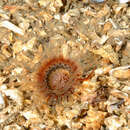en
names in breadcrumbs


Cerianthus lloydii are rarely caught by fishing boats since they retreat into their tubes as the trawl net approaches. Divers are usually able to dig out younger and thus smaller animals from their tubes without too much laborious and time-consuming work. (Grzimek 1972)
The class Anthozoa, the class that the Cerianthus lloydii belongs to, has 6200+ species. They are very plentiful in the oceanic world. (Raven and Johnson 1999)
There are no real negative issues of the Cerianthus lloydii.
Cerianthus lloydii are admired for their beauty and resistance. They are found in the aquariums of many people and add color and brightness to the aquarium. Since they come in a variety of colors it is easy to see how they would be admired. (Nichols and Cooke 1971)
Cerianthus lloydii are carnivorous, eating hydromedusa and small crustaceans that swim into their tentacles. If kept in captivity, they may also take small pieces of meat and worms. (Grzimek 1972) Around the mouth opening there are two whorls of tentacles: in the middle are short oral tentacles and, around this, over 100 long, fringing tentacles arranged in up to four rings. (Meglitsch and Schram 1991) Like all Cnidarians, they have no anus so the indigestible food remains are expelled through the mouth. (Grzimek 1972)
Cerianthus lloydii can be found in the Atlantic and North Sea. They inhabite soft substrates such as sand and mud (Grzimek 1972). They can also be found in rock crevices (Banister and Campbell 1985)
Biogeographic Regions: atlantic ocean (Native )
Cerianthus lloydii live in soft substrates such as sand, mud and rock crevices. They can live along the coastline or deep in the ocean. They have no real boundaries as they can occur deep in the ocean or in shallow water. (Grzimek 1972)
Aquatic Biomes: benthic ; coastal
Cerianthus lloydii are anywhere from a few centimeters in length, up to 40 centimeters into the substrate. Cerianthus lloydii vary in color. Their tentacles are usually a delicate brown to gray. Their tentacles can cover a circle almost 60 cm in diameter in search for prey. (Grzimek 1972) Cerianthus lloydii differ from other Cerianthus sp. in their internal anatomy and mode of growth, particularly of the septa in the gut. They live in a tube made of discharged nematocysts and sand grains. They have two groups of tentacles, one encircling the mouth, the other around the edge of the disk. (Banister and Campbell 1972)
Other Physical Features: ectothermic ; radial symmetry
The fertilized eggs of Cerianthus lloydii usually develop into planula larva, that settle and develop into polyps. Like other Anthozoa, there are no medusa stages in burrowing anemones. C. lloydii can also reproduce asexually by means of budding off. (Raven and Johnson 1999)
Parental Investment: no parental involvement